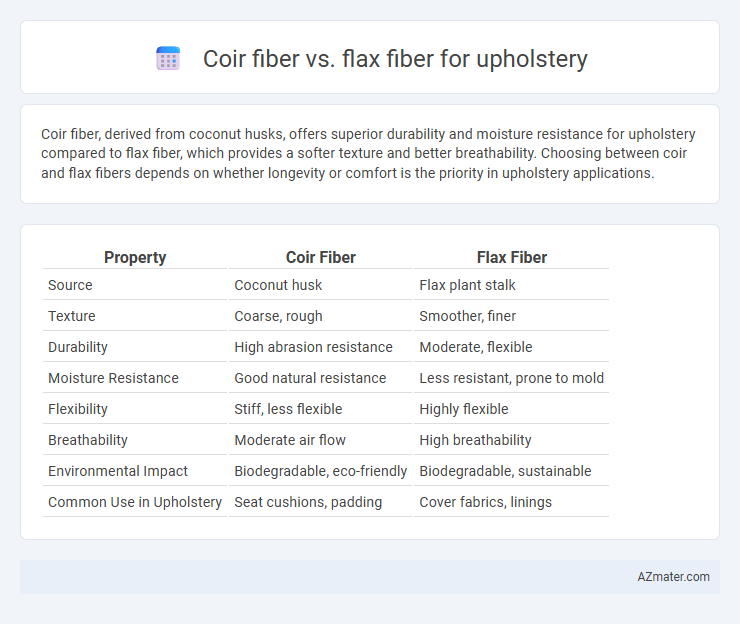Coir fiber, derived from coconut husks, offers superior durability and moisture resistance for upholstery compared to flax fiber, which provides a softer texture and better breathability. Choosing between coir and flax fibers depends on whether longevity or comfort is the priority in upholstery applications.
Table of Comparison
| Property | Coir Fiber | Flax Fiber |
|---|---|---|
| Source | Coconut husk | Flax plant stalk |
| Texture | Coarse, rough | Smoother, finer |
| Durability | High abrasion resistance | Moderate, flexible |
| Moisture Resistance | Good natural resistance | Less resistant, prone to mold |
| Flexibility | Stiff, less flexible | Highly flexible |
| Breathability | Moderate air flow | High breathability |
| Environmental Impact | Biodegradable, eco-friendly | Biodegradable, sustainable |
| Common Use in Upholstery | Seat cushions, padding | Cover fabrics, linings |
Introduction to Natural Fibers in Upholstery
Coir fiber, extracted from coconut husks, offers exceptional durability and moisture resistance, making it ideal for upholstery padding and cushioning. Flax fiber, derived from the flax plant, provides a lightweight yet strong alternative with excellent breathability and natural luster, often used for fabric covers and blends. Both fibers contribute eco-friendly benefits, enhancing sustainability in furniture manufacturing with biodegradable and renewable properties.
Coir Fiber: Properties and Characteristics
Coir fiber, derived from coconut husks, boasts high durability, natural water resistance, and excellent ventilation, making it ideal for upholstery applications requiring robust cushioning and moisture management. Its coarse texture and stiffness provide superior support and resilience compared to flax fiber, which is softer and less resistant to wear. Coir's eco-friendly, biodegradable nature combined with its ability to resist microbial growth enhances the longevity and sustainability of upholstered furniture.
Flax Fiber: Properties and Characteristics
Flax fiber, derived from the flax plant, is known for its high tensile strength, durability, and natural luster, making it an excellent choice for upholstery applications requiring resilience and aesthetic appeal. Its moisture-wicking properties and resistance to pilling contribute to long-lasting fabric integrity, while its biodegradability ensures environmental sustainability. Compared to coir fiber, flax offers a softer texture and greater flexibility, enhancing comfort and versatility in upholstery designs.
Sustainability and Environmental Impact
Coir fiber, derived from coconut husks, is biodegradable and requires minimal chemical processing, making it a sustainable choice for upholstery with low environmental impact. Flax fiber, sourced from the flax plant, offers strong, durable, and biodegradable material with a lower water footprint compared to cotton, contributing to eco-friendly upholstery solutions. Both fibers support sustainable practices, but coir's utilization of agricultural waste enhances waste reduction, while flax's rapid renewability aids in soil health and carbon sequestration.
Comfort and Support Comparison
Coir fiber offers firm support and excellent durability, making it ideal for structured upholstery that maintains shape over time. Flax fiber provides a softer, more breathable cushioning layer, enhancing comfort with natural moisture-wicking properties suitable for relaxed seating. While coir excels in resilience and support, flax delivers superior comfort and a gentle touch, allowing for a balanced upholstery design based on usage needs.
Durability and Longevity
Coir fiber, derived from coconut husks, offers exceptional durability and high resistance to wear, making it ideal for upholstery subjected to heavy use. Flax fiber, extracted from the flax plant, provides a strong yet flexible material with moderate longevity but is more prone to fraying over time compared to coir. The natural resilience of coir ensures upholstery maintains structural integrity longer, while flax requires more maintenance to preserve its appearance and strength.
Aesthetic Differences in Upholstery
Coir fiber in upholstery offers a coarse, rustic texture with natural brown and tan hues, providing a warm, earthy aesthetic suited for casual or tropical-themed interiors. Flax fiber presents a smoother, finer texture with a light beige to creamy color palette, lending itself to elegant, refined upholstering styles that emphasize subtle sophistication. The visual contrast between coir's rugged appearance and flax's sleek finish significantly impacts the overall design, influencing choices based on desired ambiance and style coherence.
Cost Analysis: Coir vs Flax Fiber
Coir fiber typically offers a lower-cost alternative to flax fiber in upholstery applications due to its abundant availability and less intensive processing requirements. Flax fiber, while more expensive, provides superior durability and a finer texture, justifying its higher price point in premium furniture markets. Cost analysis reveals coir as ideal for budget-conscious projects, whereas flax suits high-end upholstery demanding long-lasting quality.
Maintenance and Care Requirements
Coir fiber upholstery requires minimal maintenance due to its natural resistance to moisture and mildew, making it suitable for humid environments, but it benefits from regular vacuuming to remove dirt and debris. Flax fiber, while offering a softer and more breathable texture, demands more careful care, including occasional gentle cleaning and protection from prolonged exposure to moisture to prevent mold and weakening of fibers. Both fibers benefit from avoidance of harsh chemicals and direct sunlight to maintain durability and appearance over time.
Choosing the Right Fiber for Your Upholstery Needs
Coir fiber, derived from coconut husks, offers excellent durability and natural water resistance, making it suitable for upholstery in high-traffic or humid areas. Flax fiber, sourced from the flax plant, provides a softer texture and superior breathability, ideal for comfortable seating with a natural aesthetic. Selecting between coir and flax fibers depends on balancing toughness and moisture resistance against softness and comfort for specific upholstery requirements.

Infographic: Coir fiber vs Flax fiber for Upholstery
 azmater.com
azmater.com